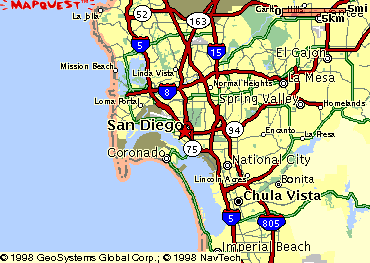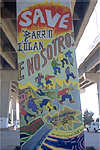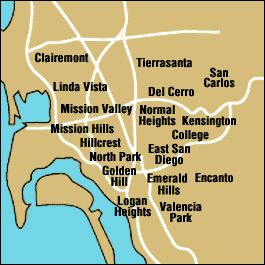Environmental Justice Case Study: Industrial Pollution in Barrio Logan
San Diego, California

San Diego, California is composed of a mix of residential, commercial, and industrial sites. During and after World War II, the San Diego area experienced tremendous development due to rapid population growth and capitol investment in the military and industrial complexes. This rapid growth and development did not allow proper residential planning for the development of communities areas. Therefore residential areas and industrial zones are integrated. As a result, some communities exhibit an unhealthy mixture of homes, schools, and environmentally hazardous facilities.
This pattern is overwhelmingly apparent in the community of Barrio Logan, where people live in close proximity to chemical intensive industries which produce, store, and emit toxic chemicals and wastes into the neighborhood. Although the industries in Barrio Logan produce some of the largest quantities of hazardous waste in the City of San Diego, the residents have only learned in the last twenty-some years about all the health risks involved in living there. It is no coincidence that this community, living in one of the most polluted areas of the city, is composed of over 90% minority residents.
In an effort to address the myriad of environmental health risks facing their community, the residents of Barrio Logan have organized under the name, Environmental Health Coalition (EHC). This group is "dedicated to the prevention and clean up of toxic pollution threatening our health, our community, and our environment."
Back to Table of Contents
The primary health threat to the residents of Barrio Logan is toxic air emissions.
These emissions come from a variety of sources, including small, often unregulated
industries, the Port Authoritys use of toxic fumigants in their shipping yards
near Barrio Logan, and from noxious fumes emanating from the San Diego sewage
system. In order to realize the goal of the EHC, "the prevention and clean up
of toxic pollution," we much analyze each of the individual problems contributing
to the health hazards of the Barrio Logan environment.
 The problem of toxic emissions from small businesses is directly linked to the layout of the city. Since the area was developed, Barrio Logan has had very few zoning regulations, resulting in the construction of homes adjacent to chrome plating and chemical supply businesses, among others. Until there are sufficient zoning regulations to separate chemical-intensive business from neighborhoods, the health of Barrio Logan residents is in jeopardy.
The problem of toxic emissions from small businesses is directly linked to the layout of the city. Since the area was developed, Barrio Logan has had very few zoning regulations, resulting in the construction of homes adjacent to chrome plating and chemical supply businesses, among others. Until there are sufficient zoning regulations to separate chemical-intensive business from neighborhoods, the health of Barrio Logan residents is in jeopardy.
Additional sources of toxic emissions affect this community. Until recently, the Port Authority, charges with the responsibility to operate the San Diego shipping yards, routinely fumigated cargo with the deadly chemical methyl bromide. This policy of spraying this toxic pesticide was recently halted after a long court battle with the EHC, but not until the Barrio Logan residents were exposed to the chemical for five years.
Toxic pollution is not the only air quality issue Barrio Logan residents face. Intense odors often emanate from the sewage pumping station owned by the Kelco Corporation located adjacent to Perkins Elementary School in Barrio Logan. These smells are not only unpleasant, they are distracting to teachers and students alike. For five years, the community has battled both the city and Kelco Corporation, an industrial company with a history of dumping violations. Although the City has made modest efforts to find and fix problems with the pumping station, the violations continue. Many residents in the community rightfully believe that the Kelco Corporation is illegally dumping chemicals into the pumping station, causing malfunctions and leaks. So far, the modest attempts to solve the problem have failed, resulting in the contamination of Perkins
Elementary School and in the community at large.
Back to Table of Contents
This organization began in 1980 with the goal of preventing illness, "resulting from exposure to toxins in the home, workplace, and in all communities in San Diego." The organization is involved with several campaigns for pollution prevention and environmental justice.
 The City of San Diego
The City of San Diego
The EHC works closely with the City to resolve environmental problems the community faces. The City is responsible for creating zoning regulations necessary to separate chemical and industrial facilities form residents, but until recently has neglected this responsibility. The City government recognizes the voting power of the vocal Barrio Logan residents, but the community is fairly small and can not always exert enough political pressure to sway the City. The political power of the shipping and manufacturing industries in Dan Diego unduly influences policy and often stifles the work of the EHC.
 The San Diego Unified Port District
The San Diego Unified Port District
This is another political entity with control of the air quality in Barrio Logan. Their resistance to eliminating the methyl bromide fumigation has exposed the entire community to years of unnecessary exposure to this toxic pesticide.
This local paper has played an important role in this community's struggle form toxic-free neighborhoods. The publicity that the Union-Tribune gives to the struggles in Barrio Logan is a mixed blessing for the EHC and community residents. While staff editorials, such as "Barrio Bogeyman (7.31.97)," criticize the EHC for preferring "provocative hyperbole" to "good science," the Union-Tribune does provide a public forum for discussing and raising awareness of the issues facing Barrio Logan.
Back to Table of Contents

Barrio Logan ( in Logan Heights on the above map ) is located southeast of downtown San Diego and just north of National City, California. The population of Barrio Logan and the surrounding communities, according to 1990 U.S. Census data, are composed primarily of people of Hispanic origin. The following Census Tracts represent Barrio Logan and the surrounding area.
Ethnic Composition of Barrio Logan
|
CATEGORY
|
TRACT #36
|
TRACT #38
|
TRACT #39
| TRACT #49
| TRACT #50
| TRACT #51
| AVERAGE PER TRACT
|
|
|
% Hispanic
|
80.0
|
68.3
|
75.6
| 88.0
| 91.5
| 49.7
| 77.8%
|
|
|
% Black
|
13.8
|
17.8
|
21.7
| 10.2
| 24.1
| 23.9
| 17.1%
|
|
|
% White
|
3.8
|
3.1
|
2.7
| 1.5
| 5.6
| 26.6
| 5.0%
|
|
|
MEDIAN INCOME
|
18,801
|
-
|
13,662
| 17,561
| 15,208
| 13,056
| $16,270
|
|
|
% BELOW POVERTY
|
34.7
|
-
|
48.1
| 36.8
| 48.3
| 50.2
| 41.4%
|
|
Source: 1990 U.S. Census data
The Census data illustrates more than just Barrio Logan's racial or cultural make-up. The data indicate that this neighborhood has a larger proportion of minority residents when compared to San Diego County. This fact, coupled with the uncharacteristically high levels of toxic chemical storage, production, and emissions in Barrio Logan, provides evidence for an inequitable distribution of environmental health hazards among San Diego County residents
Barrio Logan compared with the County of San Diego
|
AREA
|
MEDIAN INCOME
|
% BELOW THE POVERTY LINE
|
PERCENT MINORITY
|
|
Barrio Logan
|
$15,657
|
43.6%
|
92.8%
|
|
San Diego County
|
$35,022
|
11.3%
|
34.6%
|
Source: 1990 U.S. Census data
The connection between toxic emissions in Barrio Logan and the minority status of the community is just one of two connected issues. The first, as mentioned above, is a distribution of environmental burden weighing inequitably on minority communities. However, the Census data also suggests a link between environmental health risks and income. Compared to the rest of San Diego County, Barrio Logan residents have a lower median income that the rest of San Diego County. In fact, residents in this neighborhood are almost four times more likely to live below the poverty line than those living in the surrounding area.
Back to Table of Contents
The Environmental Health Coalition
The EHC, Environmental Health Coalition, is divided into four different campaigns in order to address the multiple issues facing local Latino communities, such as Barrio Logan.
TOXIC-FREE NIGHBORHOOD CAMPAIGN
The goal of this campaign is to separate residents from the toxic chemicals and pollution produced by local industries. To achieve this, the EHC actively works to organize communities of color throughout the San Diego area. Once these communities are organized, they can work within the political structure of the City to rezone residential areas and reduce the toxic emissions in minority neighborhoods.
CLEAN BAY CAMPAIGN
The EHC advocated for pollution prevention and clean-up of the San Diego Bay in accordance with the Federal Clean Water Act. This campaign encompasses both the Military Toxics Project and the San Diego Watershed Protection Project.
BORDER ENVIRONMENTAL JUSTICE CAMPAIGN
In conjunction with groups in Tijuana, Mexico and other organizations in San Diego, the EHC works to resolve and prevent pollution problems.
COMMUNITY ASSISTANCE PROGRAM
In addition, the EHC works in the community. They listen to concerns of the people and explore means to which equity can be served, unity can be attained, and support groups and meetings can be organized.
The EHC is a successful grassroots organization primarily due to its effective use of the Alinsky Model for resource mobilization. This model includes:
Framing the issue. While working to educate the community about environmental health threats in Barrio Logan, the EHC frames, or clarifies, the issues. Often, the language used in EHC publications, such as Toxinformer, is designed to frame the issues as conflicts. "Community Voices Rise in Opposition to Nave . ." is and example of one headline that clarifies this point: The community is against the Navy.
Presenting the issue to speak to the people's self interests. this is not a difficult task for the EHC, as the issues are relevant not only to the residents self interests, they are relevant to everyone's physical health. "Hazards of Toxics," an article in the EHC's Communities At Risk pamphlet, outlines the health hazards of the chemicals produces, stored and emitted in Barrio Logan. This information is critical for appealing to the residents' self interest.
Celebrating victories. This is an integral part of the EHC's strategy for keeping the community organized and powerful. The EHC organized celebrations not only for large victories such as the termination of methyl bromide fumigation at the Port Authority, but even small victories in order to maintain a cohesive organization.
Building the organization to sustain itself, rather than focusing only on solving one problem. The EHC, through constant efforts to reach out to the community, involves a growing number of people in protest and thus increases its political power.
The San Diego Unified Port District fought the EHC for years to retain the "right" to fumigate fruit shipments in the shipping yards near Barrio Logan. The Port District's rationale for maintaining their fumigation program was purely economic: without fumigation, the Port District could not accept shipments of foreign fruit and thus sacrifice profits. The Port District was under constant pressure from the EHC in the form of legal suits and community protests. This pressure forced the Port District to respond with a SLAPP (Strategic Lawsuit Against Public Participation ) suit in November of 1996. This suit effectively silenced the EHC from publicly opposing the fumigation, thus securing the Port District's legal right to continue its methyl bromide fumigation program. The SLAPP suit was appealed but upheld on June 6, 1997, bolstering the Port District's position. After five years of struggling with the community, however, the Port District announced an end to its use of methyl bromide. According to Port commissioners, the decision was not made out of health concerns, but out of the community fears. "Sometimes, it does not matter if there are actual impacts (to people's health), if it's a fear and a concern," said Mike McDade, the Port Commission Chairman (from San Diego Union-Tribune, 7.30.97).
The City of San Diego
The City of San Diego is responsible for several of the environmental health threats facing the Barrio Logan community. The zoning in Barrio Logan, or lack thereof, contributes to the problem because it places chemical intensive Industry adjacent to residential neighborhoods. In an effort to address this, the EHC and other community organizations worked with the City to separate polluting industries from the Barrio Logan neighborhoods. Through these efforts, the City has been awarded a $100,000 EPA grant to relocate some of Barrio Logan's chemical intensive industries.
The City is also responsible for maintaining the sewage system throughout the City. Although Barrio Logan residents, including the children at Perkins Elementary School, have complained of sickness due to the nearby sewage pumping station, the City has not acted to correct the problem. This is a common reaction of government agencies, as they often require "proof" that the pumping station is responsible for the complaints. The EHC is currently working to find "proof" of the suspicions that waste from nearby Kelco Corporation is responsible for damaging the pumping station.
Barrio Logan residents face many environmental health threats. The air they breath is polluted, schools are inundated with sewage odors, and the adjacent San Diego Bay is contaminated with toxins. However, this minority community has not let the situation defeat them. Through the community organizing work of the EHC, actions have been taken to reduce the treats to the community. Only through continued community action in City government, in the courts, and in bulking relationships with local pollution industries will the EHC and Barrio Logan achieve their goal: Toxic Free Neighborhoods.
Back to Table of Contents
"Barrio Bogeyman", July 31, 1997. San Diego Union-Tribune.
Communites At Risk , April 1993. Environmental Health Coalition.
"Give the EHC credit for finding the gas," August 9, 1997. San Diego Union-Tribune.
"Neighbors elated by victory over Port fumigation", July 30, 1997. San Diego Union-Tribune.
Toxinformer, July, 1997. Environmental Health Coalition.
United States Census bureau, 1990 Report.
Contact the Environmental Health Coalition to find out how you can help.
Back to Table of Contents
 The problem of toxic emissions from small businesses is directly linked to the layout of the city. Since the area was developed, Barrio Logan has had very few zoning regulations, resulting in the construction of homes adjacent to chrome plating and chemical supply businesses, among others. Until there are sufficient zoning regulations to separate chemical-intensive business from neighborhoods, the health of Barrio Logan residents is in jeopardy.
The problem of toxic emissions from small businesses is directly linked to the layout of the city. Since the area was developed, Barrio Logan has had very few zoning regulations, resulting in the construction of homes adjacent to chrome plating and chemical supply businesses, among others. Until there are sufficient zoning regulations to separate chemical-intensive business from neighborhoods, the health of Barrio Logan residents is in jeopardy.
 The Environmental Health Coalition
The Environmental Health Coalition